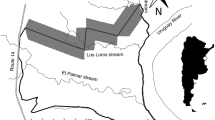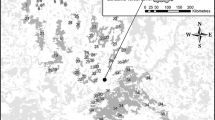Abstract
The endozoochorous dispersal of vascular plant species by red deer (Cervus elaphus) was investigated in three forest areas of Schleswig-Holstein and Lower Saxony. The primary aim of this study was to determine of which plant species and in what numbers diaspores are dispersed by red deer, an animal with eminently large home ranges during a single day as well as over the year. A second aim was to examine the significance of endozoochory for plant species composition and diversity in forests. Special emphasis was placed on whether there are differences between the three study sites and in the course of the vegetation period. Freshly deposited faecal pellet groups were collected in the forests on five dates between May and November 2002 and viable seed content was determined by greenhouse germination (seedling emergence method). A total of 28,009 individuals representing 59 vascular plant species were detected in 220 dung samples. Red deer appears thus as an important vector for endozoochorous dispersal of plants. The number of seedlings found in the faecal pellets differs between plant species and research areas as well as in the course of the vegetation period. Dung seed content is largely dominated by one species, Urtica dioica. Grouping the species found in dung according to their habitat preference showed that mainly species that occur in forests as well as in open vegetation and non-forest species were dispersed endozoochorously, while species occurring mainly under a closed canopy were present in the excrements only in low numbers.





Similar content being viewed by others
Notes
Not regarding the few specimens of European elk (Alces alces) that have recently immigrated from the East
References
Anon (2001) SPSS for Windows. Release 11.5. SPSS Inc, Chicago
Bierzychudek P (1982) Life histories and demography of shade-tolerant temperate forest herbs: a review. New Phytol 90:757–776
Bonn S, Poschlod P (1998) Ausbreitungsbiologie der Pflanzen Mitteleuropas. Ulmer, Wiesbaden
Cornelius R, Hofmann RR (1999) Huftiergemeinschaften und Vegetation – Entstehung, Zerstörung und schrittweise Rekonstruktion eines natürlichen Gefüges. Natur- Kulturlandsch 3:382–389
Dzieciolowski RM (1969) Foods of the Red deer as determined by rumen content analyses. Acta Theriol 6:89–110
Dzieciolowski RM (1974) The use of pellet-group counts to census Red deer (Cervus elaphus L). Int Congr Game Biol 11:559–563
Entzeroth R (1979) Floristische Aufnahme von Wildgehegen im Rheinland zur Ermittlung der von wiederkäuenden Schalenwildarten verschmähten Pflanzen. Z Jagdwiss 24:187–194
Fischer A (1987) Untersuchungen zur Populationsdynamik am Beginn von Sekundärsukzessionen – Die Bedeutung von Samenbank und Samenniederschlag für die Wiederbesiedlung vegetationsfreier Flächen in Wald- und Grünlandgesellschaften. Diss Bot 110. Cramer, Berlin
Gebert C, Verheyen-Tixier H (2001) Variations of diet composition of red deer (Cervus elaphus L.) in Europe. Mamm Rev 31(3):189–201
Gill RM, Beardall V (2001) The impact of deer on woodlands: the effects of browsing and seed dispersal on vegetation structure and composition. Forestry 74(3):209–218
Hatlapa H-HM (1988) Über die Bedeutung der Großen Brennnessel (Urtica dioica) bei der Äsungswahl des Rotwildes (Cervus elaphus L.). Z Jagdwiss 34(1):51–54
Heinken T, Raudnitschka D (2002) Do wild ungulates contribute to the dispersal of vascular plants in central European forests by epizoochory? A case study in NE Germany. Forstw Centralbl 121:179–194
Heinken T, Hanspach H, Schaumann F (2001) Welche Rolle spielt die endozoochore Ausbreitung von Pflanzen durch wildlebende Säugetiere? Untersuchungen in zwei brandenburgischen Waldgebieten. Hercynia N F 34:237–259
Heinken T, Hanspach H, Raudnitschka D, Schaumann F (2002) Dispersal of vascular plants by four species of wild mammals in a deciduous forest in NE Germany. Phytocoenologia 32(4):627–643
Hodgson JG, Grime JP, Hunt R, Thompson K (1995) The electronic comparative plant ecology. Chapman & Hall, London
Hofmann RR (1976) Zur Charakterisierung des wiederkäuenden Schalenwildes nach Äsungstypen. Beilage zu DJV-Nachrichten, 2/1976
Hofmann RR (1978) Die Stellung der europäischen Wildwiederkäuer im System der Äsungstypen. In: Wildbiologische Informationen für den Jäger–Jagd und Hege, pp 9–18
Homolka M (1990) Food of Cervus elaphus in the course of the year in the mixed forest habitat of the Drahanska Vrchovina highlands. Folia Zool 39(1):1–13
Kraus P (1987) Vegetationsbeeinflussung als Indikator der relativen Rotwilddichte. Z Jagdwiss 33(1):42–59
Malo JE, Suárez F (1995) Herbivorous mammals as seed dispersers in a Mediterranean dehesa. Oecologia 104:246–255
Malo JE, Suárez F (1996) Cistus ladanifer recruitment—not only fire, but also deer. Acta Oecol 17:55–60
Malo JE, Jimenez B, Suárez F (2000) Herbivore dunging and endozoochorous seed deposition in a Mediterranean dehesa. J Range Manage 53:322–328
Mitchell B, McCowan D (1984) The defecation frequencies of red deer in different habitats. Annual Report of the Institute of Terrestrial Ecology, 1983, pp 15–17
Mrotzek R, Halder M, Schmidt W (1999) Die Bedeutung von Wildschweinen für die Diasporenausbreitung von Phanerogamen. Verh Ges Ökol 29:437–443
Myers JA, Vellend M, Gardescu S, Marks PL (2004) Seed dispersal by white-tailed deer: implications for long-distance dispersal, invasion, and migration of plants in eastern North America. Oecologia 139:35–44
Oheimb G v (2003) Einfluss forstlicher Nutzung auf die Artenvielfalt und Artenzusammensetzung der Gefäßpflanzen in norddeutschen Laubwäldern. Schriftenreihe naturwissenschaftliche Forschungsergebnisse 70. Kovac Verlag, Hamburg
Pakeman RJ, Digneffe G, Small JL (2002) Ecological correlates of endozoochory by herbivores. Funct Ecol 16:296–304
Petrak M (1982) Etho-ökologische Untersuchungen an einer Rothirschpopulation (Cervus elaphus Linné, 1758) in der Eifel unter besonderer Berücksichtigung des stoffwechselbedingten Verhaltens. Schrft AKWJ-JLU Gießen 10. Enke Verlag, Stuttgart
Prien S (1997) Wildschäden im Wald. Ökologische Grundlagen und integrierte Schutzmaßnahmen. Parey, Berlin
Riney T (1957) The use of faeces count in studies of several free-ranging mammals in New Zealand. NZ Forestry Service, Technical Paper 12 NZ. J Sci Technol (B) 38:507–532
Schaumann F, Heinken T (2002) Endozoochorous seed dispersal by martens (Martes foina, M. martes) in two woodland habitats. Flora 197: 370–378
Schmidt M, Oheimb G v, Kriebitzsch W-U, Ellenberg H (2002) Liste der im norddeutschen Tiefland typischen Waldgefäßpflanzen. Mitt Bundesforschungsanst Forst- Holzwirtsch 206:1–37
Schmidt M, Sommer K, Kriebitzsch W-U, Ellenberg H, Oheimb G v (2004) Dispersal of vascular plants by game in northern Germany. Part I: Roe deer (Capreolus capreolus) and wild boar (Sus scrofa). Eur J For Res 123:167–176
Stubbe C, Tottewitz F, Piegert H, Sackmann HJ, Wilke G, Gleich E (1997) Zum Einfluss des Futterangebotes auf die Defäkationsrate von Rot-, Muffel- und Rehwild. Beitr Jagd Wildforsch 22:343–346
Ter Braak CJF, Prentice IC (1988) A theory of gradient analysis. Adv Ecol Res 18:271–317
Ter Heerdt GN, Verweij GL, Bekker RM, Bakker JP (1996) An improved method for seed bank analysis: seedling emergence after removing the soil by sieving. Funct Ecol 10:144–151
Thompson K, Bakker JP, Bekker RM (1997) The soil seed banks of North West Europe: methodology, density and longevity. Cambridge University Press, Cambridge
Traveset A (1998) Effect of seed passage through vertebrate frugivores’ guts on germination: a review. Perspect Plant Ecol Evol Syst 1:151–190
Vellend M, Myers JA, Gardescu S, Marks PL (2003) Dispersal of Trillium seeds by deer: implications for long-distance migration of forest herbs. Ecology 84:1067–1072
Wagenknecht E (2000) Rotwild. Nimrod-Verlag, Suderburg
Welander J (2000) Spatial and temporal dynamics of a disturbance regime. Wild boar Sus scrofa rooting and its effects on plant species diversity. Silvestria vol 127. Swedish University of Agricultural Sciences, Uppsala
Welch D (1985) Studies in the grazing of heather moorland in north-east Scotland. J Appl Ecol 22:461–472
Acknowledgements
We are grateful to Kerstin Sommer (Lüneburg), Eckhard Kropla (forestry office of the city of Lübeck), Jan Stäcker, Peter Ohff, Matthias Schatz (forestry office of the district Herzogtum Lauenburg) and Hans-Jürgen Kelm and Rolf Ebeling (forestry office of the district Lüchow-Dannenberg) for help in collecting dung samples and to Toby Spribille for the English language revision.
Author information
Authors and Affiliations
Corresponding author
Rights and permissions
About this article
Cite this article
von Oheimb, G., Schmidt, M., Kriebitzsch, WU. et al. Dispersal of vascular plants by game in northern Germany. Part II: Red deer (Cervus elaphus). Eur J Forest Res 124, 55–65 (2005). https://doi.org/10.1007/s10342-005-0053-y
Received:
Accepted:
Published:
Issue Date:
DOI: https://doi.org/10.1007/s10342-005-0053-y




